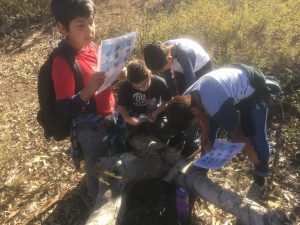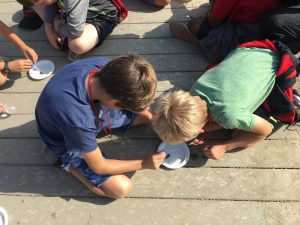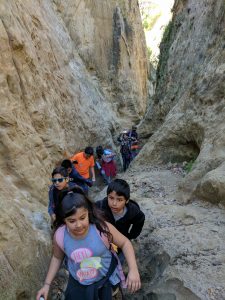Tale from the Field: Improving Teaching and Learning Through Shifts in Program Policies (Part 1 of 2)
Tara Fuad of the San Elijo Lagoon Conservancy in San Diego, California, attended a BEETLES Leadership Institute in the summer of 2017. She’s done a lot in the year and a half since attending the Institute and has used BEETLES materials and approaches to transform the way teaching and learning happens at her site– but getting there wasn’t easy! Lots of programs leave a BEETLES Institute fired up and excited to make changes in their program, only to realize that some of the structures within their program won’t allow for the kind of changes they envision to support deep, meaningful learning experiences they want students to have. Tara’s site is a reserve, where off trail exploration wasn’t allowed, and they had short contact hours, which made it challenging to truly offer meaningful explorations and connection with nature. Read on for Part 1 of an interview about how Tara addressed these challenges and more, and how she has used BEETLES to support student and nature-centered teaching at her site (and stay tuned for Part 2 next month!).
BEETLES: How did BEETLES impact your program?
Tara Fuad: “BEETLES transformed our program completely. During my ten years with the San Elijo Lagoon Conservancy, we had made attempts to move from the ‘Sage on Stage’ approach to a more engaging hands-on experience for our students, the majority of whom are in grades 3-5. But it never felt right…we created stations to WOW the students with fun things to see and touch, that seemed like a positive shift, but it still came across as contrived and somewhat superficial as we moved students from station to station. After BEETLES Leadership Institute, it became very obvious that we weren’t taking advantage of the natural wonders of the diverse habitats our 1,000-acre sanctuary had to offer. Upon returning from the Institute, I walked around the reserve with my heightened observation skills and began to imagine how we could do things differently. Now we’ve switched our focus to students engaging directly with nature. Gone are the materials-heavy stations that we had spent so much time creating. It became very clear that all you really need is a hand lens and some plastic cups, and nature will do the rest of the work for you. We always thought that in order to be a good instructor, it was our job to understand and explain nature and to point out what WE had deemed interesting and important for the students to notice and understand. Now with our student-centered approach, we’ve learned that students might have different ideas about what is interesting, and we are being responsive to that, and the students are more engaged than ever.”
BEETLES: San Elijo Lagoon Conservancy was one of the first non-residential programs that we accepted to a BEETLES Leadership Institute. Can you share what has been successful for you in implementing BEETLES in shorter programming?
Tara: “Before implementing BEETLES, our programs used to be 1.5-2 hours. Now they are all 2-5 hours. I still don’t feel like it’s enough time, but it’s a great start and big improvement. You need that much time to get the students warmed up, get used to the hand lens, and comfortable with some freedom to explore. Our programs start with I Notice I Wonder It Reminds Me Of, followed with some kind of phenomenon and focused study of one part of nature like looking at snails, or the canyon, or a disappearing log. Then we always allow time for journaling and reflecting. Between that, we’ll do a Walk & Talk and address what students find interesting. In the future, I’d like to see all of our programs move to full day or 5-hour program to have even more time.
“The teacher response to the program shift has been really positive. When asked what surprised them about students going through the program one teacher noted ‘I was surprised at how engaged the students were, especially with the insects.’ Another teacher said ‘The educators had excellent techniques to get the kids thinking, talking, and drawing conclusions.’ But my favorite quote was ‘…they acted like ‘kids,’ having fun and being excited. Sometimes in 5th grade they try to act cool, but today they were excited kids exploring the world.’”
BEETLES: San Elijo Lagoon Conservancy is a reserve, where you’re not supposed to go off trail. How did you overcome this barrier and make it possible for students to be able to explore and engage directly with nature at your site?
Tara: “I thought about it, and eventually came to the conclusion that we have 1,000 acres of protected land, what harm would it be to dedicate 5 acres to education? I was pretty adamant and clear that we couldn’t have a meaningful science education program if students had to stay on the trails. It took some legwork as the land we wanted to explore is County and State-owned, but managed mostly by the San Elijo Lagoon Conservancy. After several meetings, I was pleasantly surprised that folks eventually came around, but it did take nearly a year to get full approval. I framed it– ‘Do we want to be on the cutting edge of science education? Or do we want to be doing it the old way?’ Now, we have 10 sites at the reserve where we can legally go off trail. We picked sites that were already disturbed, and we rotate the sites where students explore to spread out the impact so it’s not all in one place. During a program, we put out a sign stating ‘education program in progress’ so visitors understand that learning is going on and that kids aren’t just trampling around nature. For now, we have mostly used the off-trail sites for The Case of the Disappearing Log activity. The kids LOVE the activity and really get into it.”
BEETLES: Have there been any unexpected applications of BEETLES during your implementation?
Tara: “It’s applicable on so many levels. We’ve incorporated BEETLES-y approaches in our public walks, school professional development trainings, and with school parent liaisons. Essentially, if you want to connect folks to nature, even the most reluctant participants are going to get on board if you use a nature and student-centered approach to teaching, like we learned about in the BEETLES institute. I have used I Notice I Wonder It Reminds Me Of with a variety of audiences, including a presentation to our Board, and it IS ALWAYS well received. We also provided the Making Observations Professional Learning Session to pre-service teachers at California State University San Marcos to demonstrate how easy it is to use the outdoors to inspire students about the awe and wonder of nature – modeling how even observing your schoolyard can be fascinating if you know HOW to observe.”
“We also made some new resources based off some of the activities and resources BEETLES has. For example, based on the Disappearing Log Key from the activity Case of the Disappearing Log, we made up an activity called the Case of the Disappearing Canyon because we have a slot canyon in our reserve. We modeled the key after the BEETLES activity, focusing on wind and water and insects as the ‘suspects’ that make the canyon disappear. The kids are FASCINATED. We also created some plant keys for our site.”
Next month, we’ll publish Part 2 of Tara’s interview! Stay tuned to hear about other structural changes Tara made to support student and nature centered teaching in her organization.






One Response to “Tale from the Field: Improving Teaching and Learning Through Shifts in Program Policies (Part 1 of 2)”
Beetles Project Tale from the Field: Improving Teaching and Learning Through Shifts in Program Policies (2 of 2) - Beetles Project • April 10th, 2019 at 3:01 pm
[…] Part 1 of an interview with Tara focused on changes she made to her organization to support student and nature-centered teaching at her site. Tara and her leadership team shifted policies to create spaces where students could go off trail, built lessons around natural features at her site instead of relying on props, integrated BEETLES resources, and restructured programming to increase students’ time outdoors. […]
Leave a Response